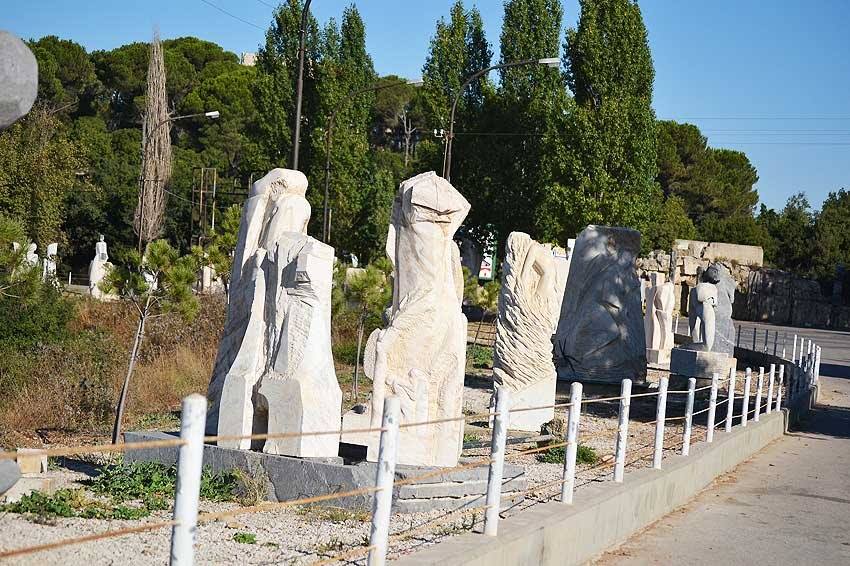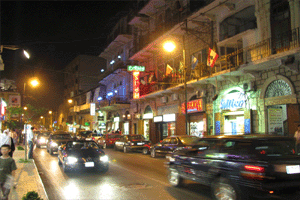The third annual International Symposium for Sculpture kicked off with an opening night ceremony on Sunday in Ras al-Jabal, Aley. The event was graced by the presence of the acting Druze spiritual leader, Sheikh Bahjat Ghaith, in addition to Culture Minister Ghassan Salameh, who spoke to the gathering on behalf of Prime Minister Rafik Hariri about the significance of the symposium and future support for the event.
Salameh described the symposium as a “cultural revival” and “an example of what the country as a whole should be experiencing.”
The idea for an annual event was hatched by the Aley Municipal Council in the mid-1990s. The chief of the Association of Lebanese Artists of Painting and Sculpture (AAPSL), Bassam Kerliles, touched upon the effect of the symposium when he said in his speech that “Aley has special status in the heart of every artist.”
Arranged along the length of a short tree-lined road, the thought-provoking pieces create a white marble procession that stands as a testament to the rising importance of sculpture in Lebanon. Sunday night these sculptures also gave off a sense of mystery as thick fog closed in on the event.
Although the artists themselves come from a wide array of backgrounds, much of their work shares a surprisingly similar initial presence. Ranging in height from 1.5 meters to 2.5 meters, the pieces are primarily white marble, incorporating both smooth and rough surfaces. Some of the sculptures depict faces or writhing bodies emerging from the stone, while others suggest spacecraft or other mechanical devices.
Regardless of some of their initial similarities, however, the differences in the artists’ techniques creates a varied spectrum of styles, some of which seem reminiscent of ancient Greek statues, while others appear to have been modeled on a science-fiction theme.
By exhibiting such diverse pieces, the symposium is trying to appeal to all artistic tastes. The move is also an attempt to popularize sculpture, and perhaps more importantly, give the country an international reputation as an artistic and a culturally cutting-edge center.
Since the first symposium opened in Aley two years ago, the event has grown.
The original event was modest in scale, involving 30 artists from Syria, Jordan and Lebanon. Just a year later however, the number of participants at the second symposium had more than doubled. What’s more, they came from 11 Arab countries and 10 European countries, in addition to Georgia, Armenia and the United States.
This year’s symposium received an avalanche of applications. More than 200 artists from five continents forced the Aley Municipal Council to create a committee to select only the most famous and renowned applicants for inclusion. In the end, some 40 international artists were approved from no fewer than 30 different countries, as well as 18 local sculptors.
Following last year’s event, the sculptures were put on permanent display in Ras al-Jabal. Those from 1999 can be found at the Casino du Aley facing Ras al-Jabal. This year’s sculptures will remain on display until Aug. 27.
Aside from a celebration of a sometimes overlooked art form, the symposium also served as a forum in which the concerns of Lebanese artists were expressed. Addressing the MPs present, Kerliles spoke on behalf of the country’s sculptors. “Your presence here is proof of your love of art and your support for every artist,” he said. “We know how much you have given to Lebanese artists, but we would like more attention, especially for members of the fine arts community who are living in isolation and have no rights or immunity.”
Kerliles went on to list the requests of the members of the fine arts community who, he said, “have been waiting for social security services since 1996.” Among their wants are a national museum for fine arts, and for the sculpture division at the Lebanese University which was “shut down ages ago” to be reopened.
Salemeh also addressed these concerns in his speech, vowing to do more to support next year’s event.
In fact, the importance of art for tourism was a central theme in many of the speeches delivered on Sunday. Arguing that art can open invaluable tourism opportunities, Kerliles stressed the importance of government funding, saying that he “hopes that the arts will be one of the sectors for investment since it attracts lots of tourists.”
Expressing his pleasure with the symposium, Aley Mayor Wajdi Mrad said that “this municipal council is aware that traditional tourism has become passe” and suggested the need for “modern ideas” that do not undermine local traditions.
Information Minister Ghazi Aridi also stressed the importance of Aley’s experience, “especially in the fields of development, infrastructure, art and tourism,” and he urged all municipal councils throughout the country to imitate the Aley approach.
“This is a leading experience that has propelled this city into an advanced position,” he said.
The event’s international flavor was illustrated not only by the abundance of foreign participants, but also in the participating and supporting organizations. Primarily sponsored by the Bank of Beirut and the Arab Countries, this year’s symposium was also supported by the International Federation of United Cities (FMCU), the Arab Cities Organization (ACO), UNESCO’s AIAP section and the AAPSL.
In his welcoming address, George Rafiar, the head of FMCU in Belgium, said Aley was “setting an example for development in social and cultural activities,” and that the symposium has helped the region become “a city of art and culture.”
The highlight of opening night was the awarding of medals to Mrad and Salameh by Ghassan Samman, the ACO deputy assistant director-general of advertisements and publications, for their efforts in establishing and continuing the symposium.




